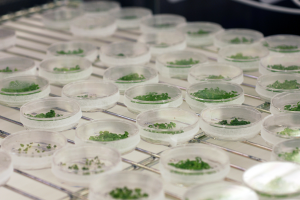When I was young, Pluto was still a planet and nine was my lucky number, so I really liked that we had nine planets in our solar system – it made it easy for me to remember. My love of astronomy out-lasted Pluto’s status as a planet, and as I write this I am actually wearing a solar system necklace; each planet is represented, yet it only has eight planets on it.
Imagine an alien. If you’ve been influenced by movies and television at all, the creature you’re picturing is probably two-legged, two-armed, bipedal and with a reminiscently human layout – head, eyes and mouth somewhere near the top. And while most of us recognise that this vision of extra-terrestrial life is a bit silly, conversations about life elsewhere in the universe are often still painfully unimaginative.
Genetically modified organisms, especially plants, get a lot of hate. People – even some very environmentally conscious people – seem to fear or hate GM crops. Yet, as someone who is very worried about climate change, very worried about the human-induced mass extinction event that is happening before our eyes, and worried about the livelihoods of farmers and about those people that have so little food they go to bed hungry every night…
Genes associated with stress tolerance in corals have fewer epigenetic markers, enabling a rapid response to environmental change. In six species of coral, the team from the University of Washington found DNA methylation, a common epigenetic molecular marker, differed between different genetic regions, and was extremely low in genes relating to stress tolerance. Epigenetics could play a key role in determining how corals cope with climate change.
Continue reading →
A group of bottlenose dolphins in Shark Bay, Western Australia, use a clever trick to access prey on the sea floor – they cover their beaks with marine sponges to protect themselves from sharp rocks as they search for food. 30 years after the behaviour was first reported, scientists have now found that individuals improve with practice, peaking just when it matters most.
Continue reading →
If you ever owned a pet stick insect as a child, you might have noticed them swaying back and forth at the end of a twig, but until recently, nobody knew what this strange behaviour was for.
Continue reading →
Thanks to Dorothy Floyd for pointing out that we have known anecdotally that this behaviour was likely a form of camouflage for several decades! (see
Floyd (1987) Keeping Stick Insects)
How do you make a parasite less harmful? It might be as simple as forcing them to stick around.
Amanda Gibson from Indiana University performed experimental evolution with the nematode worm Caenorhabditis elegans and a parasitic bacteria (Serratia marcescens), comparing different scenarios for how the parasite was passed on. Under most circumstances, parasites continued to cause their hosts harm throughout the 20-generation experiment. Only when each strain of parasite was allowed to infect the same host strain, generation after generation, did the parasite evolve to become less harmful.
Continue reading →
Wallabies living near humans breed later in the season, potentially missing valuable resources that could mean the difference between life and death for their growing offspring.
New research published last month in Proceedings B that found that light pollution in Australia is putting the tammar wallaby (Macropus eugenii) out of sync with the seasons. Robert and colleagues from La Trobe University in Melbourne studied wallaby breeding near urban areas and in natural bush, and found that human light pollution prevents the marsupials from responding to light cues that normally signal the start of the breeding season. Wallabies living near humans had lower levels of melatonin, a hormone linked to the sleep-wake cycle, and gave birth on average 27 days later than wallabies in wild conditions. The authors say that this may lead to a mismatch between the birth of young wallabies and food availability.
Continue reading →
For male elephant seals, the fight to secure a mate can be vicious, even deadly. So they try everything they can to avoid it. This is a pattern biologists see again and again – across the animal kingdom, males have evolved to use signals to assess each other’s prowess and avert costly physical confrontations. In most cases, these signals are honest – they accurately convey an individual’s size, strength or dominance. But new research shows this is not the case for Elephant seals, which have evolved a more sophisticated system.
Continue reading →
Organic food is often sold as being the greener alternative. By not pumping toxic chemicals into the environment, we expect that organic farms should do less harm to our wildlife, health and the climate. But new research suggests that current organic farming practises are actually worse for the environment.
Continue reading →
The brilliant mathematician and biologist JBS Haldane is famously quoted as once having said, “God had an inordinate fondness for beetles”. He was referring to the fact that nearly half of all insect species known are beetles, but over 50 years after his death, scientists are still gaining new insights into their amazing success. A new study reconstructing the beetle family tree suggests that it is the versatility of beetles that has allowed them to survive even the most testing of times.
Continue reading →
One scientist found his laboratory stink bugs were laying different colour eggs on the black and white squares of a crossword printed on the newspaper lining of their cage. This small observation led him to begin a series of experiments that show how female stink bugs are able to selectively provide sun protection for vulnerable eggs.
Continue reading →
New research published last week describes how black widow spiders destroy their mate’s nests to deter rival males.
Continue reading →
All content is Copyright © 2009 - 2019 Claire Asher



